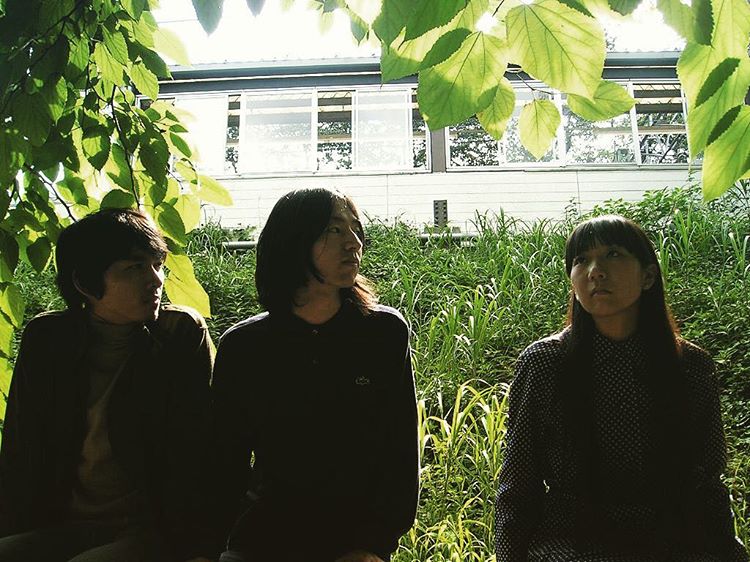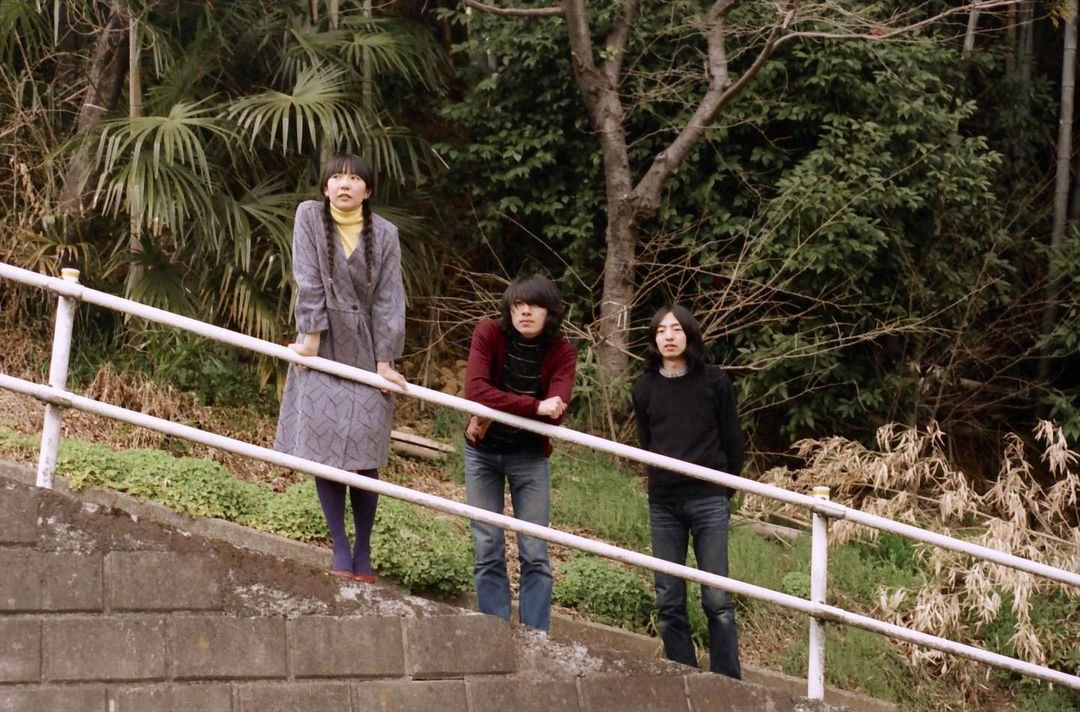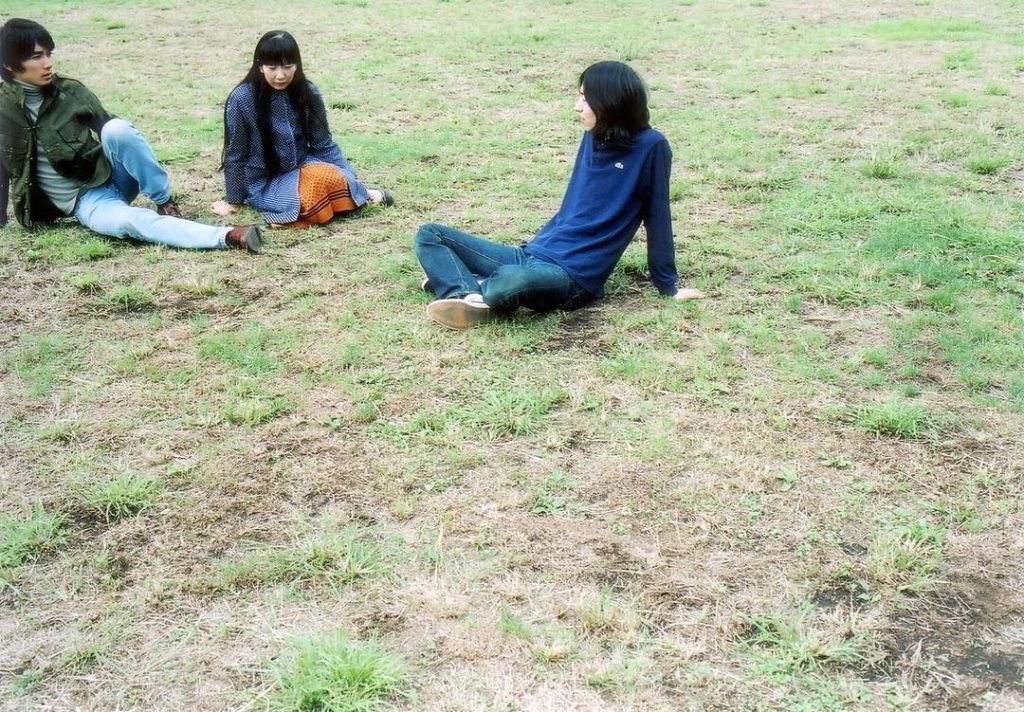According to Lamp, their third release, Komorebidoori ni te, was one of the toughest recordings of their career. Thankfully, their hard work paid off: I think it’s fair to call Komorebidoori ni te an absolute classic album that has stood the test of time. This interview from 2005 was published in the free magazine “bounce,” later re-posted on Tower Records Online in slightly edited form.
Original interview & text: bounce.com (parts one & two)
English translation: Henkka
Lamp online: website, label, blog, Facebook, Twitter, Spotify, YouTube, SoundCloud, Instagram
You can buy Lamp’s music directly from the band, both physically and digitally, on Bandcamp.
Lamp — a three-piece band that debuted in April of ’03 with their mini-album, Soyokaze Apartment 201. Their third album, Komorebidoori ni te, clearly showcases the members’ stubbornness in their attitude towards music — it’s a work of zero compromise. The harmonies of their male-female twin vocals, already highly praised since their debut, have been refined even further, and the gradation between their rhythms and their carefully selected tones has become even more vivid and colorful than in the past. We’re glad to present to you an interview from behind the scenes of this new-generation, pop music masterpiece.
— This being your third album, it feels to me like your approach to songwriting is becoming more and more varied. Did you do anything differently when recording this album?
Taiyo Someya: Compared to our first and second albums, the recording process for this one was the most difficult of them all. We hit several slumps along the way. Having people telling you that they like your work is definitely a nice feeling, but when it comes to music there’s no definite way of telling what’s really good or not. Right? But for those of us making the music, the one thing that does make sense is the numbers — that is, how much or how little our releases sell. With our previous album we felt confident that we’d done a better job than on our first album, and yet, it simply didn’t get as good of a response. That caused us to lose sight of what it was that we should be creating. We’d reached our limit.
Yusuke Nagai: On our previous works we’d had something like a concept. “Let’s make it this kind of an album.” We were conscious of even making the album covers reflect those concepts. But with this album, when we first started actually working on it, our motivation was at an all-time low. We didn’t have any sort of an overall vision for the album in the beginning.
Kaori Sakakibara: On Komorebidoori ni te, we left the CD covers up to the designer. In doing so, I think it shows the band in a different way — and hopefully makes us a bit more recognizable.
— Did all three of you share that worry of not knowing what to do with the release as you were working on it?
Sakakibara: Yes. We were constantly dropping and adding songs that would be included on it and such… it was an endless cycle of creation and destruction.
— I assume there were some changes in the actual recording work itself, too.
Nagai: We were quite free to work on it as we liked. And I suppose that’d be fine if I was the kind of person who could control himself. But in my case, what would happen is that I’d lose that feeling of tension midway and thus lose interest in the song altogether. So allowing us that freedom actually only made the recording process take longer.
— Were you also in charge of deciding which recorded takes to keep and which to discard?
Someya: That was the tricky part. Trying to get a take that both me and Nagai would deem acceptable — that’s what made the recording process so lengthy. That was one thing that wasn’t good about these recording sessions.
— Let’s try to get away from all these negative feelings by talking about the album itself. (laughs) While this is something I already thought upon hearing your previous release, on this album it feels like both of your vocals sound even more stable than before. The higher register backing vocals in particular came out much better than on your previous releases, I felt.
Nagai: While a part of it might be thanks to improved technique, I think it’s more to do with the fact that I believe I finally managed to just get the knack of singing those backing vocals properly. Up until this album I always felt like I could never quite reach the ideal I was striving for, but I do feel pleased with how, for example, the ending of “Yokaze” turned out.
— It feels like the backing vocals also became more varied: most of them so far seemed to just run alongside certain lines, but on this new album you even have those scat-like vocalizations.
Nagai: I’m pretty sure no one actually pays attention to backing vocals as much as we think they do — you hardly ever hear people saying stuff like, “hey, this band has really good backing vocals.” So a part of me does think there aren’t any other bands out there who put this much effort into their backing vocals. (laughs)
Sakakibara: Those were fun to record. I feel like we managed to do something really nice with them, so I wish people will try listening to the album while paying attention to that aspect of it, too.
— Not only does this hold true for the variation in the backing vocals, but also the gradation of sounds in any given song has gotten so much more detailed. Instruments come in… only to disappear the next moment. It feels like the songs are made up entirely of those detailed, overlapping sounds.
Someya: “Shimi Darake no Uta” is one song we specifically tried to make sound like that. Same goes for the pre-chorus of “Yokaze.” There’s no point in doing something we’ve already done on our past releases, so we thought we’d give it a go.
— There’s something about Lamp that’s closer to a production team rather than a band, right? You don’t see anything wrong with having someone else play on the songs if they can do it better than you. I think that’s another thing one can also feel more strongly on this release — like you’re one step removed from the songs yourselves.
Someya: Yes. We’re never thinking about how to make our guitar playing sound the most skillful it can be or something — it’s all about the songs. Especially in creating this album, we were always working on it with the mindset of, “how do we present these songs to the world in the best state possible?”
— There’s an abundance of different sounds on the album, so I was wondering: did you ever feel like stripping some of them away? I’m asking because I believe some of your personal favorite albums are very sparse, sound-wise…
Someya: We don’t think of our music as something that could compete with the likes of artists whose songs consist only of an acoustic guitar and vocals. I don’t believe our songs are particularly musically accomplished. If anything, we strive to make something unusual — that feeling of something sounding out-of-place is what we want to make our “thing.”
Sakakibara: I think once you attain that performer’s outlook on life, it’s possible to make music that’s both simple as well as captivating. But for young musicians like us, I feel like even if we were to make something really simple, it wouldn’t really sound like anything much at all.
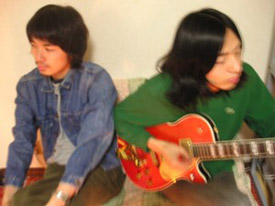
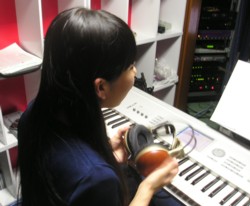
— As a band, you strike me as a group that’s very stoic about “making good music” — I think it expresses Lamp’s sincerity towards music in general. What do you think is the root cause for you being so stoic about music?
Someya: We feel like there’s no reason for us to make something that already exists somewhere out there. Or, if I was to take that statement a step further… Even if I felt that I had something good, I would no longer feel like doing it if I heard someone else doing it, too. We’ll often make references to 70’s Japanese artists. “This song sounds like this or that artist” or whatever, but I feel confident in saying that there is no artist out there besides Lamp — past or present — that’s doing the kind of music that we do. There certainly is a sense of wanting to convey to other musicians our tastes; our attitude towards music. We’re just stubborn people, and we’re well aware of that ourselves. (laughs)
Nagai: No doubt there are lots of 70’s sounds and tones that I love, but I’ve never consciously thought about trying to write music that sounds distinctly 70’s.
— Finally: as an album, what sort of a position will Komorebidoori ni te occupy in Lamp’s discography?
Someya: As we’ve really only just finished working on it, it’s hard to be objective about it yet. But, it’s an album that we as a band felt very obsessed over. I feel like with each and every chord progression and atmosphere on the album, we managed to actualize whatever it was we were trying to do. The scenery you might conjure up upon hearing this album is different from our last release, but I’m also confident that it’s different than anything else out there by other artists.
Bonus
As a bonus, here is some track-by-track commentary on the songs included on Komorebidoori ni te. These have been paraphrased by me from an interview published in an issue of Splash! magazine. (I’ve included the principal songwriters in parenthesis.) There is also a longer “liner note” describing “Konya mo Kimi ni Telephone Call” posted on Lamp’s blog by Someya. Enjoy!
1. “Konya mo Kimi ni Telephone Call” (music & lyrics: Someya)
The song was recorded in November of 2003 — it is the group’s oldest song on the album. Things added into the song after it was released on the compilation album, found in fairground, include strings and horns and some other, minor things. Nagai feels something a bit Yamashita Tatsuro-ish about the title — he jokes that some listeners may have taken offense to its somewhat cheesy 80’s-ness.
Someya’s liner notes
“I think it was right around the time we’d finished recording our second album, Koibito e, that we were contacted by the label of Misawa, a keyboardist who had helped out on our previous recordings, offering us to take part in a compilation album. We only had a month to record a song from scratch, and so this song was written in less than a week.
Even now it’s a song we always perform live — it’s become something like our signature song. However, to me its writing process felt rather painless. I’m not sure why, but I do feel quite pleased with how it turned out.
When we first started working on Komorebidoori ni te, we didn’t have any intention of including it on the album. As we were just about done with its production work, we felt like no matter how we ordered the other seven songs, we just didn’t feel pleased with the album as a whole. It was when we’d hit that road block when Nagai or Sakakibara — I’m not sure which — came up with the idea of including this song on the album. We then took the take that was put on the compilation album, added some further instrumentation, and gave it a remix. Ultimately, it ended up having the important role of being the album’s opening track.
We gave Suzuki Jun — who had first recorded for us on the song “Ai no Kotoba” (from the album Koibito e) — full control as to the keyboard parts on this track. As you can hear, all of his parts on it sound very nice. To me there’s a very strong feeling of this song having become magical the very moment that Jun recorded his parts on it.
I’m very pleased with how well the lyric “konya mo kimi ni denwa wo kakete shimau yo” matches with its accompanying melody.”
2. “Komorebi no Kisetsu” (music: Someya, lyrics: Sakakibara)
This song was originally supposed to be the opening track on the album, hence the way it was written to sound like something that might get the listener “fired-up.”
3. “Dakiyosetai” (music & lyrics: Nagai)
Nagai already had a prototype of this song when the group was working on its second album, but he was unsuccessful in bringing it to completion. While he is embarrassed of the title (“wanting to embrace you“), it wasn’t titled that way in jest: Nagai wrote the song about a girl he used to like, and whereas previously he’d purposefully used vague language in his lyrics, he chose not to do so with this song. He took extra care with his singing and arrangement in order to bring out the song’s tenderness.
4. “Shimi Darake no Uta” (music & lyrics: Someya)
Another song whose writing process Someya describes as having been “relatively painless.” The song — its very first chord anyway — was inspired by a song called “Love Suite” by Nirvana (the one from the 60’s). Someya openly admits that the lyrics to the song are so difficult, even he himself has trouble reading the kanji characters.
5. “Kimi wo Matsu Aida ni” (music & lyrics: Nagai)
Aside from the vocals, this song wasn’t actually performed by Lamp: while the song was composed by Nagai, it’s the only song on the album where he doesn’t play the bass, and Someya only watched — as he did on other Nagai songs like “Dakiyosetai” and “Tsumetai Yoru no Hikari.” According to Nagai, the reason they took this approach is because he wasn’t quite sure how to go about finishing it without making it sound like “just another Lamp song.” He finished writing it to an extent, but then gave free reign to the people performing it.
6. “Yokaze” (music: Someya, lyrics: Sakakibara)
Someya is happy with the ideas he was able to incorporate into the song’s outro — keeping the same melody as in the intro, but using different chords. Nagai thinks it’s the song with the “highest level of perfection” on the album, while Sakakibara also praises its “easy-to-remember melody.”

7. “Tsumetai Yoru no Hikari” (music & lyrics: Nagai)
The music video (which features Nagai) was filmed in snowy Nagano. While Nagai himself isn’t terribly pleased about this song, Someya genuinely loves it, and this helped Nagai warm up to it as well. It wasn’t an easy recording process: as they were working on it, Nagai noticed the differences between the recorded version and his original demo becoming bigger and bigger, and he struggled in trying to realize his original intentions with the song. He says that while he still has lingering qualms as to the song’s vocals and arrangement, this was the best he could do at the time. Sakakibara agrees: she thinks Nagai did manage to do the best job he possibly could, but also says that the song could’ve been something different had it been recorded under different circumstances. Nagai does also offer a more positive take on the subject: the group always strives for perfection, yet they sometimes can’t help but fall short of it — perhaps that, Nagai thinks, is part of what makes Lamp so good.
8. “Haru no Utsuro” (music & lyrics: Someya)
Someya wanted to try doing something “rather weird” with this song, and he feels that the group succeeded in doing so. The cuica that can be heard on the song was played by Someya himself.
In closing, the group says the recording of this album was marked by struggle until the very end, with temporary losses of motivation throughout. They describe the experience as having been difficult, lengthy, time-consuming, and mentally draining. The group is in agreement that whereas with their second album they managed to bring it to its intended completion, when it came to this recording process — with the members unsure if what they had were truly the best versions of their material — the band felt like they forced themselves to bring work on the album to a close. Sakakibara adds that the recording process made her feel even irritated at times — to the point where she wanted to just “dropkick something” (!) — but she doesn’t think any of that is audible on the material. Someya offers, though, that expressing that sort of irritation on a recording would be terribly easy. But doing the opposite? Well, that ties into what Someya has often called the art of “expressing something without actually saying it.”
Someya thinks that with this release, Lamp have finished one part of what they’ve wanted to express — he feels like they’ve reached a limit as to how far they can take the art form of pop music. He feels that their fourth album (which would end up being Lamp Gensou) will be what marks the beginning of “part two” in the group’s evolution.
